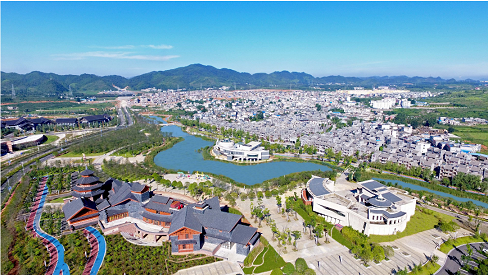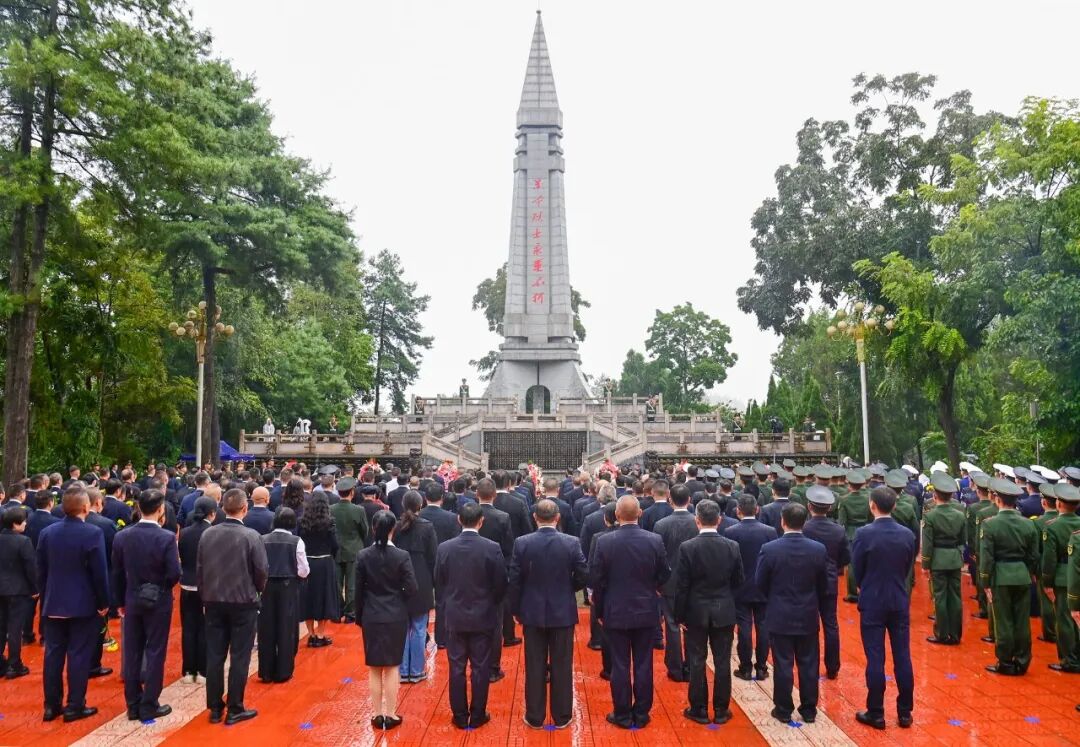- Profile Jurisdictions GOV DEPARTMENTS Cultures Travelling Educate
-
Qianxinan Buyi and Miao Autonomous Prefecture is situated at the junction of Yunnan, Guangxi, and Guizhou provinces, in the transitional zone between the Yungui Plateau and the Guangxi hills, along the upper reaches of the Pearl River. As a commercial hub and strategic gateway for the neighboring regions of these three provinces, it has long been known as the “Southwest Barrier” and the “Gateway to Yunnan and Guizhou.” Surrounded by mountains and waterways, the prefecture boasts unique resources, picturesque landscapes, a simple and honest local culture, and a pleasant climate. Qianxinan belongs to the Nanpanjiang and Beipanjiang river basins within the Pearl River system, representing a typical low-latitude, high-altitude mountainous region. The terrain slopes from west to east and from north to south, with the highest elevation reaching 2,207.2 meters and the lowest at 275 meters.

The prefecture administers eight counties (cities): Xingyi City, Xingren City, Anlong County, Zhenfeng County, Pu'an County, Qinglong County, Ceheng County, and Wangmo County. These are further divided into 140 townships (subdistricts), comprising 83 towns, 43 subdistrict offices, and 14 townships (including 2 ethnic townships); along with 1,291 village (residential) committees. Beyond the Han Chinese, the prefecture is home to over 30 ethnic minorities, including the Buyi, Miao, Yi, Hui, Li, Gelao, Zhuang, Yao, Dong, Mongolian, Bai, Shui, Tujia, Manchu, Tibetan, Hani, Mulao, and Korean ethnic groups.
Established on May 1, 1982, Qianxinan Buyi and Miao Autonomous Prefecture is one of the youngest autonomous prefectures among China's 30 autonomous prefectures. Covering a land area of 16,800 square kilometers, the prefecture serves as a vital hub for goods distribution and commerce among Guizhou, Yunnan, and Guangxi provinces (regions). It is home to 46 ethnic groups, including Han, Buyi, Miao, Yi, and Hui, with a total population of 3.7703 million. Ethnic minorities constitute 44.71% of the prefecture's total population.

The history of Qianxinan's territory is profoundly ancient. Archaeological excavations at sites like Maomaodong in Xingyi and Guanyindong in Anlong confirm human habitation in the region over ten thousand years ago. The “Xingyi Man” fossils date to the late Paleolithic era. During the Shang and Zhou dynasties, tribal activities emerged, forming the Guifang Kingdom. From the Spring and Autumn and Warring States periods through the Qin, Han, and Jin dynasties, the region successively belonged to the Yelang Kingdom, Zangke Commandery, Yelang County, Yelang Commandery, and Xinggu Commandery, with its administrative boundaries undergoing multiple changes. During the Tang dynasty, the tributary system was implemented in the prefecture. During the Southern Song Dynasty, the region was divided among states like Luodian and Zhiqi. Prosperity from horse trading significantly bolstered its strength, elevating it to a major “vassal state” in Southwest China. The Yuan Dynasty implemented the Tusi system to strengthen control over local indigenous powers. In the ninth month of the 14th year of the Hongwu reign (1381) of the Ming Dynasty, southwestern Guizhou was incorporated into Ming rule. Military farming was implemented within the prefecture, reforms were made to the Tusi system, and garrisons, military posts, military farms, and fortified settlements were established, implementing a system of “combined native and military governance with separate military and administrative structures.” In the second month of the ninth year of the Shunzhi reign (1652, sixth year of the Yongli era), Sun Kewang, leader of the remnant forces of the Great Western Army, dispatched envoys to escort Emperor Yongli Zhu Youlang to Anlong Garrison in Guizhou. Anlong Garrison was renamed Anlong Prefecture (present-day Anlong County), with troops stationed for protection. In the fifteenth year, Anlong Prefecture was redesignated as Anlong Garrison. In the sixth year of the Kangxi reign (1667), Annan Station was abolished and merged into Anlong Station, establishing Nanlong Hall under Guiyang Prefecture. In the tenth month of the tenth year, Nanlong Hall relocated to Anlong Station and came under Anshun Prefecture. In the fourth month of the twenty-sixth year, Anlong Station was abolished and merged into Nanlong Hall. In the fifth year of the Yongzheng reign (1727), Nanlong Hall was elevated to Nanlong Prefecture. During the Yongzheng reign of the Qing dynasty, the “Replacing Indigenous Officials with Imperial Appointees” policy was implemented. Politically, indigenous chieftaincies and local officials were abolished, replaced by imperial appointees. Militarily, indigenous chieftaincies and local officials' armies were disbanded, replaced by Qing garrisons. In the second year of the Jiaqing reign (1797), Nanlong Prefecture was renamed Xingyi Prefecture. In the third year of the Republic of China (1914), Xingyi Prefecture was abolished, and the region came under the jurisdiction of Guixi Circuit. In the ninth year, Guixi Circuit was abolished, and all counties became directly administered by Guizhou Province. In the twenty-fourth year, the prefecture fell under the Third Administrative Supervision District of Guizhou Province.

On April 7, 1950, the Guizhou Province Xingren District Supervisory Commissioner's Office was formally established, overseeing ten counties: Xingren, Xingyi, Pu'an, Panxian, Qinglong, Guanling, Anlong, Zhenfeng, Ceheng, and Wangmo. The office was headquartered in Xingren County. In November 1951, the Xingren Supervisory Office relocated from Xingren County to Chengguan Town in Xingyi County. On November 8, 1952, the Xingren District Inspectorate Office was renamed the Xingyi District Commissioner's Office. On June 15, 1955, the Xingyi District Commissioner's Office was redesignated as the Guizhou Province Xingyi Commissioner's Office. On July 18, 1956, Xingyi Special Administrative Region was abolished. Its six counties—Xingyi, Xingren, Pu'an, Qinglong, Panxian, and Guanling—were transferred to Anshun Special Administrative Region, while Anlong, Zhenfeng, Ceheng, and Wangmo counties were transferred to Qiannan Prefecture. On July 18, 1965, Xingyi Special Administrative Region was reestablished with its headquarters in Chengguan Town, Xingyi County. Five counties under Anshun Special Administrative Region—Xingyi, Xingren, Panxian, Pu'an, and Qinglong—along with four counties under Qiannan Prefecture—Anlong, Zhenfeng, Ceheng, and Wangmo—were incorporated into Xingyi Special Administrative Region. On November 13 of the same year, Anlong, Zhenfeng, Ceheng, and Wangmo counties were abolished. Subsequently, Anlong and Wangmo Buyi and Miao Autonomous Counties, and Zhenfeng and Ceheng Buyi Autonomous Counties were established, all remaining under Xingyi Prefecture. In 1967, Xingyi Prefecture was renamed Xingyi Region. In January 1971, Pan County was redesignated as a special district under the jurisdiction of Liupanshui City. On September 21, 1981, the State Council approved the abolition of Xingyi Prefecture and the four autonomous counties of Anlong, Zhenfeng, Ceheng, and Wangmo, establishing Qianxinan Prefecture and the four counties of Anlong, Zhenfeng, Ceheng, and Wangmo. On May 1, 1982, Qianxinan Prefecture was formally established with its seat in Xingyi County. On November 6, 1987, with State Council approval, Xingyi County was abolished and Xingyi City was established.
contact details
Tel:00-86-0859-3223221
Address:No. 16, Shajing Street, Xingyi City, Guizhou Province, China
Working hours:Weekdays: 8:30-12:00 14:30-18:00
